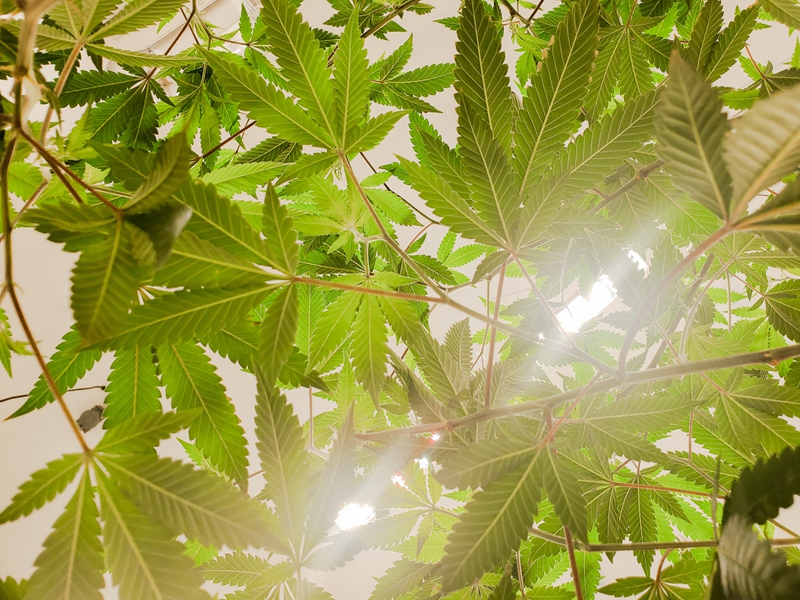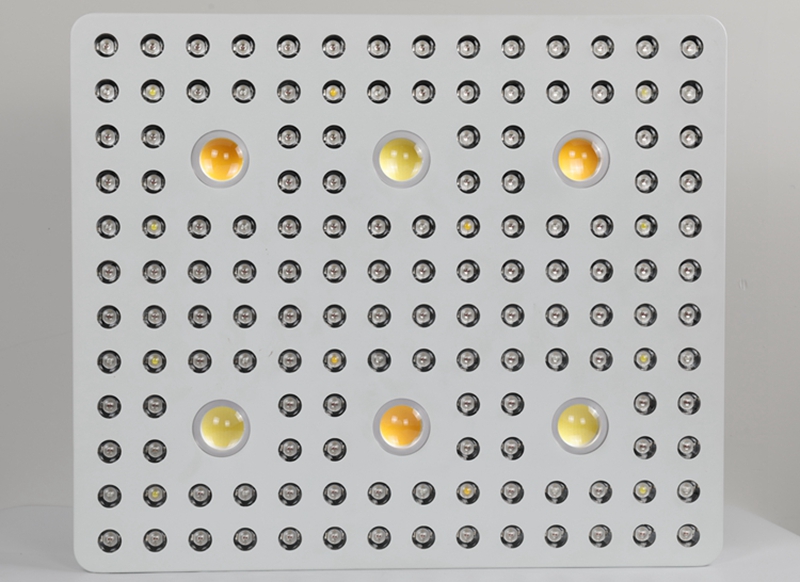
Privacy statement: Your privacy is very important to Us. Our company promises not to disclose your personal information to any external company with out your explicit permission.

Nowadays, with the emergence of LED Grow Light, more and more growers no longer use traditional hid and T5 fluorescent lamps. Compared with HID light source, LED emits less heat, which means that the proximity of LED planting lamp and canopy is different from that of traditional planting lamp.
In this article, we will summarize the lighting requirements of various plants, including cannabis, according to the growth stage of plants, how to determine the appropriate distance between LED lighting from plant canopy to the growth of nourishing plants, and the importance of PPFD (PAR) and other popular growth lamp terms, to understand how the best growth distance affects different stages of plant growth.
How to measure the light used for plant growth?
Let's quickly define par and PPFD.
Par (photosynthetically active radiation) describes the visible part of the spectrum that plants "see" and use for photosynthesis (400nm-700nm). PPFD (photosynthetic photon flux density) measures the amount of light (PAR) received by plants over time. PPFD represents the optical density received by plants over time, expressed in micromolar [photons] per second per square meter.
Imagine PPFD is the way like sun spread the light on the leaves. When sunlight touch on plants, the leaves collect energy. PPFD is a measurement of the amount of light (photons) that the sun spread on plants. PPFD is an important indicator, because it can help growers accurately measure the light intensity of photosynthesis at the canopy level. This is also important because lights that are too close to the canopy can cause burning, fading, stunted growth or discoloration.
How far we should keep the Lea Light between plant?
For seedlings, LED growth lamps should normally be installed between 24-36 inches above the plant canopy, but this depends on the power of the light source (Watts). Place the LED planting lamp as far away from the seedlings (~ 36 inches) - this will keep the heat and light intensity at a low level and help prevent the seedlings from drying. Once the root system is established and begins to sprout, the lamp can be moved closer (usually within the first 2-3 weeks).
During plant growth, led planting lights should be 12-24 inches from the top of the canopy. At this stage, photosynthesis needs more light, so the light source should be located near the plant.
As plants enter the flowering stage, the demand for strong light decreases. The top leaves of the canopy should be 18-24 inches away from the light source to produce flowers. It is at this stage that the plant grows tall and produces fruit. Depending on the light and how you want the crops to grow, you don't have to change the height of the light during flowering, especially when you don't want tall plants.
How far should Led Grow Lights keep the distance during seedlings?
During the initial stage of growth, the seedlings are fragile, only need few light. If you don't want to increase the intensity too fast, as the seedlings will reproduce in a more gentle way. Depending on the size of the light, it is safe to keep the growing light between 24 to 36 inches from the top of the soil.
How far should Led Grow Light keep away when marijuana cloning?
Marijuana cloning is a process in which cuttings or cuttings from mature plants are used to grow another plant of the same species. The light distance of the LED above the clone is different from the height of the seedling. For clones, they will need strong light to start. Depending on the light intensity and maturity of the plant, the difference between 14 to 36 inches from the top of the canopy may be significant.
How far should led grow light be used?
As plants grow, their needs change. After the completion of the vegetative stage, the plant enters the flowering or "flowering" stage. For mature factories, they have become a necessary place to flourish. At the flowering stage, led planting lights should be located between 16 to 36 inches from the plant canopy. Moving the growth light closer will increase the light intensity and maximize photosynthesis. However, if the growth lamps are too close to the plants, they may lead to expansion, spread and even damage to plants.
What about other stages of growth?
According to each stage of growth, plants need different levels of light. In order to know exactly how far light a plant should grow, it is important to consider the different stages of growth. It is also important to consider the power output of the growth lamp, which is usually related to the power of the light source, which is the main factor to determine the optimum distance of LED when starting the growth process.
Plant growth can be roughly divided into three parts- seedling, nutrition and flowering.
seedling stage
In the initial stage of seedling, the LED growth lamp should be placed above the plant to avoid soil drying.
Some growers may try to use high-intensity light to dynamite seedlings to promote faster growth, but it will not help until the plant is established. At this early stage, the seedlings were too fragile and a more moderate approach was needed. Once the plant is mature, higher light intensity is needed to promote photosynthesis.
Nutritional period
In the nutritional stage, plants respond well to strong light - it is during which plants gradually mature and grow rapidly by photosynthesis. To increase light intensity, led planting lamps should be located closer to the plant canopy. Solid, healthy stems and roots are key to successful yield repetition.
Increasing light intensity can promote the growth of nutrition, but it is important to monitor plants closely to ensure that the adverse symptoms caused by excessive or insufficient light are paid attention to.
Flowering period
Flowering is the last stage of the plant growth cycle - during which fruit production and stem growth accelerate. With the transition from vegetative stage to flowering or flowering stage, the best way is to "stage" the transition process. To do this, gradually raise the height of the LED planting lamp away from the plant ceiling (use the height recommendations outlined earlier). Monitor distance closely and keep in mind the height and flowering requirements of the specific plant / crop.
Adverse effects of excessive light intensity
When plants like marijuana receive too much light at any stage, they usually show symptoms of distress. Since LEDs don't emit too much heat, the main problem that needs to be monitored closely is any sign of "light burn.". Other side effects associated with growth lights too close to the plant canopy may be discoloration or growth disruption / growth irregularities. Both must be quickly identified and adjust the height of the growth lamp accordingly.
There are signs of mild burning in cannabis plants, including upward leaves and so-called "bleaching.". Bleaching is the white or yellow color on the leaves closest to the light. When the veins of the plant turn green and the rest turn yellow, light burns can also be identified.
Increase the distance of light - marijuana and other plants
As growers move crop production indoors, it is becoming more and more common to use LED planting lights to produce marijuana. LEDs also benefit growers because they can use specific spectra to provide more targeted lighting for different crops. Compared with traditional light sources, other benefits of considering LED plant growth lights include lower power consumption, lower forward heat and increased output in a shorter time.
The distance of the increase in light should reflect the height and uniformity expected by the grower, and spread with leaves and healthy flowers. If we look at the crop needs of salad vegetables or lettuce compared to cannabis, we will find salad vegetables and lettuce suitable for short-term, broader growth, while cannabis is more suitable for higher and narrower growth.
No matter which crop you use, farmers and cannabis growers want to get the highest quality per unit yield in a shorter growth cycle.
The distance of traditional plant light
Before led gradually popularized in the indoor growth application, traditional high intensity discharge lamps (HID) (such as high pressure sodium (HPS) and metal halide) and fluorescent lamps have been widely used. Historically, the first cost of these lights is much lower than led planting, so they are cheaper to buy and therefore available to large indoor growers.
HID or fluorescent lamp shall be more than the distance from led to the plant canopy. Part of the reason is that they emit more positive heat than LEDs, but they are also available only in several different watts / light outputs. The installation distance of growth lamps varies with each stage of growth and depends on the number of tiles used.
Although the traditional plant growth lamps are less expensive to use for the first time (at lower prices), they need more maintenance over time - bulbs need to be replaced and / or cleaned more frequently - and there are obvious limitations in lighting control - many of them will not dim and may take a long time to turn on all optical output.


Privacy statement: Your privacy is very important to Us. Our company promises not to disclose your personal information to any external company with out your explicit permission.

Fill in more information so that we can get in touch with you faster
Privacy statement: Your privacy is very important to Us. Our company promises not to disclose your personal information to any external company with out your explicit permission.